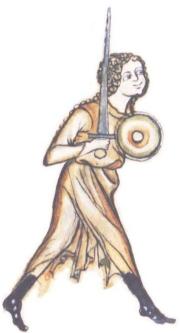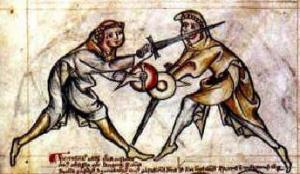I.33
 Notes on this presentation
Notes on this presentation
The following presentation of I.33 was composed by Dieter Bachmann, 2003 on behalf of the Freywild, a historical fencing school in the Czech Republic. It was determined that Mr. Bachmann's presentation was the best and most comprehensive presentation of the I.33 on the Internet, and therefore, it was felt that it was redundant to attempt to create yet another presentation of the same material. Most of the original presentation remains intact, however, some changes in the structure were incorporated with the intent to help improve the navigation and accessibility of the original presentation. Any additional content by AEMMA added to this presentation is highlighted in purple.
Description | History | Translation | Text | Contents | Index | References
 |
|
The I.33 manuscript (also called Walpurgis (cf. fol. 32) or Tower Fechtbuch; Tower of London manuscript I.33, Royal library Museum, British Museum No. 14 E iii, No. 20, D. vi., ink and water colour on parchment) is the oldest Fechtbuch preserved. It was created in Germany around 1290; it may therefore be considered as still dating from the age of the crusades. The technique presented is one of two unarmoured opponents fencing with a one-handed sword and a buckler. This, together with the intriguing fact that the fencers depicted are a monk and a 'scholar'/pupil (and on the last two pages, a monk and a woman), seems to suggest that the subject matter treated is not one of warlike or knightly fighting, but rather an art of self-defense outside the warrior class. Also, the drawings are in an unbloody and relaxed style, giving the impression that already, we have here an art of fencing that is in no direct relation with serious fights to the death, but rather a kind of hobby of a monk. Repeatedly, the text makes mention of the pupils (scolaris; discipulus 4r, 4v) - or the youths (iuvenis, fol. 9v) or clients (clientulum, fol. 4r, 12v, 13r) of the priest.
 |
| |
It seems, therefore, that a monk, possibly a retired knight, was offering fencing lessons to young noblemen. The drawings appear to have been made by a different person (cf. fol. 23r), but the author of the text could be the instructor himself -- in any case, remarkably often in the text, when the priest appears in a position of disadvantage, it is stressed, that this happened purposedly for pedagogical reasons. (eg. fol. 10v; but the author could of course still be different from the actual scribe, possibly a secretary to the bishop of Würzburg, see below).
Description: I was allowed to inspect the manuscript on March 13th 2003, in the Royal Armouries Museum in Leeds. I did however only have sufficient time for some general notes. The MS is bound with an unconspicuous modern (18th or 19th century) wrapping. To the inside front cover, as well as on a piece of paper glued to the MS, earlier owners have written notes (fol. i-iii). The MS itself consists of 32 leaves of parchment, each bearing ink drawings and text on both sides. The clothes of the characters depicted has been coloured in black, blue, green and brown without any recognizable system. The text contains initials in red, as well as single letters traced with red ink and text highlighted with red ink (verses).
History: The MS became known to a broader audience only in 1997 through the article The medieval swordsman: a 13th century German fencing manuscript (Royal Armouries Yearbook 2 1997, pp. 129-136) by Jeffrey L. Singman (Forgeng).
This article provides a good overview of the history of the MS and of its contents; the MS is first mentioned in the de veris principiis artis dimicatoriae of Heinrich von Gunterrodt (1579). Gunterrodt relates that he had chanced upon a book with fencing monks, which Johannes Herwart von Würzburg, fencing master to Prince Friedrich Wilhelm had found in a monastery in Franconia at the time when he was serving under Markgraf Albert. (the name of Johannes Herwart appears on fol. 7r). The MS came into the possession of the dukes of Sachsen-Gotha and in the 18th century, it appears in the catalogue of the duchal library. It disappeared during WW2 and resurfaced at a Sotheby's auction in 1950, where it was purchased by the Royal Armouries. Alphonse Lhotsky has dated the MS to the late 13th century and identifies the scribe as a secretary to the bishop of Würzburg (Hils, H.-P., Meister Johann Liechtenauers Kunst des langen Schwertes, Frankfurt am Main / New York, 1985, p. 85). The name of the tutor is probably Liutger (fol. 1v; c.f. Frank Cinato and Swordforum).
 |
the 'finder' left his name on page 13 (fol. 7r)
|
Translation: The text of the MS is accessible to me in the form of a photocopy of a transcription. I made a german translation in 2003 on the base of which I later compiled an english translation.
At the time of my initial translation, I had no possibility to verify this transcription beyond what is possible from the photocopy scans available on the internet (cf. references). In the meantime, I have gotten hold of high resolution colour scans of the MS. These images now appear in reduced size alongside the text.
Text in grey marks a hand different from the main text. The symbol of the cross  (signum crucis) marking the beginning of a new sequence, I give as (+).
(signum crucis) marking the beginning of a new sequence, I give as (+).
fol. i.-iii. (binding):
Notes, probably made when the MS was in
Gotha.
quaternum .i.: fol.
1r
1v
2r
2v
3r
3v
4r
4v
5r
5v
6r
6v
7r
7v
8r
8v
quaternum .ii.: fol.
9r
9v
10r
10v
11r
11v
12r
12v
13r
13v
14r
14v
15r
15v
16r
16v
quaternum .iii.: fol.
17r
17v
18r
18v
19r
19v
20r
20v
21r
21v
22r
22v
23r
23v
24r
24v
quaternum .iv.: fol.
25r
25v
26r
26v
27r
27v
28r
28v
29r
29v
30r
30v
31r
31v
32r
32v
Introduction; the
seven wards --
1r /
first ward (below the arm) --
2r
(and 11v,
15r )
/
second ward (right shoulder) --
9r /
third ward (left shoulder) --
12r /
fourth ward (above the head) --
14v /
sixth ward (breast)
17r /
seventh ward (longpoint) --
17v /
"upper longpoint" --
21r /
"fiddle-bow" --
22r /
"special" longpoint --
23v /
fifth ward (right side) --
27r /
"special" longpoint --
30r.
German:
albersleiben
2r
durchtreten, durchtritt ('stepping through')
2v,
9r,
9v
halpschilt ('half shield')
2r,
3r,
8v,
13r,
14v,
23v,
24v,
25r,
27v,
28r,
29r,
32r
krucke
4r
langort ('long point')
1r,
1v,
6v,
14r,
16r,
17v,
20r,
21r,
23r,
23v,
24v,
25r,
26r,
27r,
30r
nucken
3v
schiltslac ('shield thrust')
2r,
2v,
16v,
18r,
23r,
25r,
29r,
30v
schutzen ('protection')
3v,
9r,
26v,
28r,
30r,
31v,
32r
stich ('stab')
3v,
4r,
20r,
28v
stichschlac ('stab-thrust')
2r,
10r
vidilpoge ('fiddle-bow')
22r,
22v
Latin: (conventions for the translation)
custodia `ward'
calceo `step (through)'
contrarium `counter'
defendo `defend'
dimicator; dimicatio, ars dimicatoria `fencer; art of fencing'
fixura `stab'
invado, intro `enter'
ligacio, ligo `binding, bind'
obsessio, obsedeo, obsessor
`displacement,
counter, counterer
(also in variants possessor etc.)
plagam recipere `execute/place a strike'
-
Septem custodie sunt, sub brach incipiende /
Humero dextrali datur alter, terna sinistro /
Capiti da quartam, da dextro latere quintam /
Pectori da sextam, postrema sit tibi langort
1r
-
Tres sunt que preeunt, relique tunc fugiunt /
Hec septem partes ducuntur per generales /
Oppositum clerus mediumque tenet lutegerus.
1v
-
Custodia prima retinet contraria bina /
Contrarium primum halpschilt, langortque secundum /
Dum ducitur halpschilt, cade sub gladium quoque scutum
(3r,
8v,
23v,
29r)
/ Si generalis erit recipit caput, sit tibi stichschlach /
Si religat, calcat, contraria sint tibi schiltschlac.
2r
-
Clerici sic nucken /
generales non nulli schutzen
3v
-
Ligans ligati contrarij sunt & irati /
ligatus fugit ad partes laterum, peto sequi.
4v,
7r,
14v,
20v,
24r,
26r,
27r,
30v,
32v
-
Dum ducitur langort, statim liga sub quoque supra.
6v
-
Dum subligaueris caueas ne decipieris /
dum subligatur capud ligantis recipiatur
19v
Since I created these pages, numerous contributions concerning the MS
appeared on the web. What follows is an incomplete selection.
- Dr. Jeffrey L. Forgeng, The Medieval Art of Swordsmanship from Chivalry Bookshelf (related swordforum-thread).
- Frank Cinato: on Lutegerus.
- I.33 flowcharts by John Jordan
- ARMA article and microfilm scans.
- Boar's Tooth has pictures of Dave Rawlings' very dynamic interpretation.
- myschwerk; czech translation.
, 2003.
 Notes on this presentation
Notes on this presentation


 (signum crucis) marking the beginning of a new sequence, I give as (+).
(signum crucis) marking the beginning of a new sequence, I give as (+).